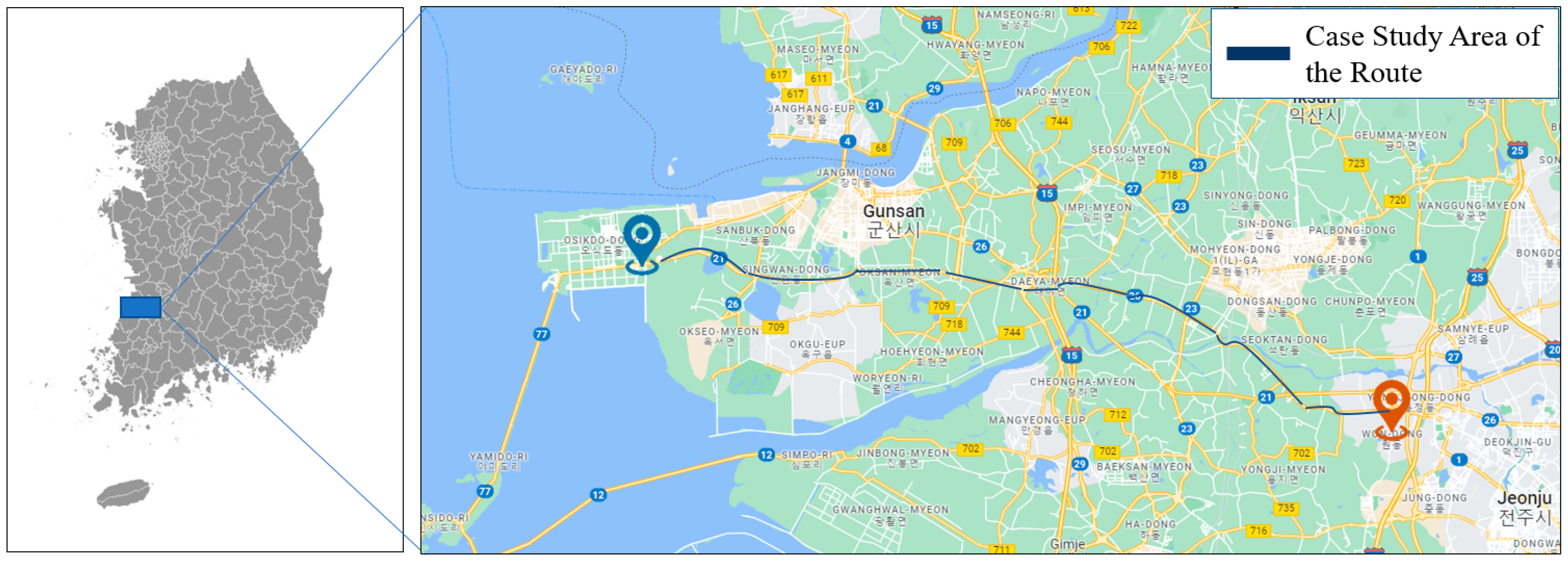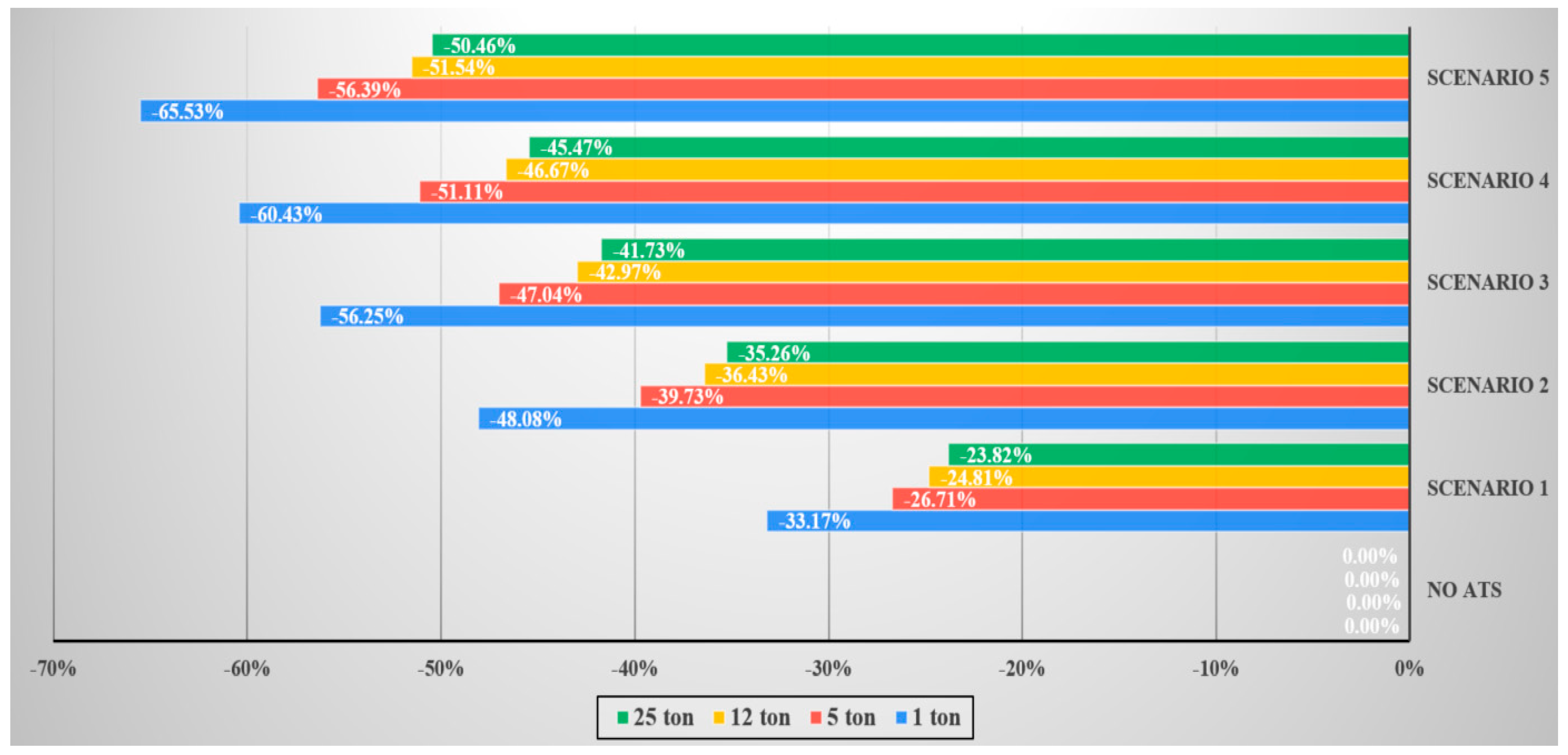Cost-Effectiveness of Introducing Autonomous Trucks: From the Perspective of the Total Cost of Operation in Logistics
Abstract
:1. Introduction
2. Background
2.1. Total Cost of Operation of Autonomous Trucks
2.2. Methodological Approaches
2.3. Research Gaps and Contributions of This Study
3. Materials and Methods
3.1. Problem Statement
3.2. Case Study Area of the Middle-Mile Route in South Korea
3.3. Analysis of Autonomous Trucks
3.4. Truck Cost Model
3.5. Literature-Based Scenario Planning
3.5.1. The Five Scenarios
3.5.2. Assumptions on the Factors
4. Results
4.1. Change in Total Costs of Operation
4.2. Breakdown of Change in Cost Factors
5. Discussion
5.1. Major Findings
5.2. Implications
5.3. Limitations of This Study
6. Conclusions
Author Contributions
Funding
Institutional Review Board Statement
Informed Consent Statement
Data Availability Statement
Conflicts of Interest
References
- Bergvall, J.; Gustavson, C. The Economic Impact of Autonomous Vehicles in the Logistics Industry; Jonkoing University: Jönköping, Sweden, 2017. [Google Scholar]
- Armstrong, G.; Kotler, P. Marketing: An Introduction, 13th ed.; Pearson: Boston, MA, USA, 2016; ISBN 978-0-13-414953-0. [Google Scholar]
- Andersson, P.; Ivehammar, P. Benefits and Costs of Autonomous Trucks and Cars. J. Transp. Technol. 2019, 9, 121–145. [Google Scholar] [CrossRef]
- Fritschy, C.; Spinler, S. The Impact of Autonomous Trucks on Business Models in the Automotive and Logistics Industry–a Delphi-Based Scenario Study. Technol. Forecast. Soc. Chang. 2019, 148, 119736. [Google Scholar] [CrossRef]
- Bao, K.; Mundy, R. Emerging Freight Truck Technologies: Effects on Relative Freight Costs; Institute for Transportation Iowa State University: Ames, IA, USA, 2018. [Google Scholar]
- Mauler, L.; Dahrendorf, L.; Duffner, F.; Winter, M.; Leker, J. Cost-Effective Technology Choice in a Decarbonized and Diversified Long-Haul Truck Transportation Sector: A U.S. Case Study. J. Energy Storage 2022, 46, 103891. [Google Scholar] [CrossRef]
- Nowak, G.; Kauschke, P.; Starke, F. The Era of Digitized Trucking: Charting Your Transformation to a New Business Model; PWC: London, UK, 2018. [Google Scholar]
- Wadud, Z. Fully Automated Vehicles: A Cost of Ownership Analysis to Inform Early Adoption. Transp. Res. Part A Policy Pract. 2017, 101, 163–176. [Google Scholar] [CrossRef]
- Engholm, A.; Pernestål, A.; Kristoffersson, I. Cost Analysis of Driverless Truck Operations. Transp. Res. Rec. 2020, 2674, 511–524. [Google Scholar] [CrossRef]
- Heutger, M.; Kückelhaus, M. Self-Driving Vehicles in Logistics; DHL Trend Research: Cologne, Germany, 2014. [Google Scholar]
- Clements, L.M.; Kockelman, K.M. Economic Effects of Automated Vehicles. Transp. Res. Rec. 2017, 2606, 106–114. [Google Scholar] [CrossRef]
- Merfeld, K.; Wilhelms, M.-P.; Henkel, S.; Kreutzer, K. Carsharing with Shared Autonomous Vehicles: Uncovering Drivers, Barriers and Future Developments–A Four-Stage Delphi Study. Technol. Forecast. Soc. Chang. 2019, 144, 66–81. [Google Scholar] [CrossRef]
- Izadi, A.; Nabipour, M.; Titidezh, O. Cost Models and Cost Factors of Road Freight Transportation: A Literature Review and Model Structure. Fuzzy Inf. Eng. 2020, 11, 257–278. [Google Scholar] [CrossRef]
- Kang, S.; Ozer, H.; Al-Qadi, I.L. Benefit Cost Analysis (BCA) of Autonomous and Connected Truck (ACT) Technology and Platooning; American Society of Civil Engineers: Reston, VA, USA, 2019; pp. 174–182. [Google Scholar] [CrossRef]
- KPMG International. 2020 Autonomous Vehicles Readiness Index; KPMG International: Amstelveen, The Netherlands, 2020; p. 70. [Google Scholar]
- International Transport Forum. Managing the Transition to Driverless Road Freight Transport; ITF: London, UK, 2017. [Google Scholar]
- Meldert, B.V.; Boeck, L.D. Introducing Autonomous Vehicles in Logistics: A Review from a Broad Perspective; Working Paper Department of Decision Sciences and Information Management; KU Leuven: Leuven, Belgium, 2016. [Google Scholar]
- Chermack, T.; Lynham, S.; Ruona, W. A Review of Scenario Planning Literature. Futures Res. Q. 2001, 17, 7–32. [Google Scholar]
- Schoemaker, P. Scenario Planning: A Tool for Strategic Thinking. Long Range Plan. 1995, 28, 117. [Google Scholar] [CrossRef]
- Narayanan, S.; Chaniotakis, E.; Antoniou, C. Shared Autonomous Vehicle Services: A Comprehensive Review. Transp. Res. Part C Emerg. Technol. 2020, 111, 255–293. [Google Scholar] [CrossRef]
- Turoń, K.; Kubik, A. Economic Aspects of Driving Various Types of Vehicles in Intelligent Urban Transport Systems, Including Car-Sharing Services and Autonomous Vehicles. Appl. Sci. 2020, 10, 5580. [Google Scholar] [CrossRef]
- Björkman, A.; Joelsson, Y. The Technical Innovation System of Self-Driving Vehicles in Road Freight Transport; KTH-Royal Institute of Technology: Stockholm, Sweden, 2018. [Google Scholar]
- Zhang, L.; Zhang, T.; Peng, K.; Zhao, X.; Xu, Z. Can Autonomous Vehicles Save Fuel? Findings from Field Experiments. J. Adv. Transp. 2022, 2022, e2631692. [Google Scholar] [CrossRef]
- Chen, Y.; Gonder, J.; Young, S.; Wood, E. Quantifying Autonomous Vehicles National Fuel Consumption Impacts: A Data-Rich Approach. Transp. Res. Part A Policy Pract. 2019, 122, 134–145. [Google Scholar] [CrossRef]
- McKinsey Global Institute. Disruptive Technologies: Advances That Will Transform Life, Business, and the Global Economy; McKinsey Global Institute: New York, NY, USA, 2013; ISBN 978-0-9895457-1-6. [Google Scholar]
- Bösch, P.M.; Becker, F.; Becker, H.; Axhausen, K.W. Cost-Based Analysis of Autonomous Mobility Services. Transp. Policy 2018, 64, 76–91. [Google Scholar] [CrossRef]
- Gkartzonikas, C.; Gkritza, K. What Have We Learned? A Review of Stated Preference and Choice Studies on Autonomous Vehicles. Transp. Res. Part C Emerg. Technol. 2019, 98, 323–337. [Google Scholar] [CrossRef]






| Variables | 1-Ton Truck | 5-Ton Truck | 12-Ton Truck | 25-Ton Truck |
|---|---|---|---|---|
| vehicle driver | 2430.00 | 2835.00 | 3240.00 | 3645.00 |
| vehicle acquisition | 611.43 | 993.57 | 1222.86 | 1528.57 |
| vehicle depreciation | 86.39 | 292.77 | 490.38 | 663.80 |
| fuel consumption | 191.47 | 340.44 | 437.64 | 547.05 |
| driver insurance | 159.22 | 247.81 | 407.18 | 472.79 |
| car insurance | 150.79 | 239.90 | 275.27 | 299.08 |
| commercial driver license fee | 1.65 | 56.98 | 202.27 | 232.66 |
| taxes | 25.39 | 86.57 | 211.60 | 250.10 |
| environment improvement payment | 171.06 | 491.76 | 881.85 | 990.95 |
| tax filing fee | 28.00 | 27.14 | 24.85 | 24.90 |
| regular inspection fee | 242.21 | 325.91 | 360.59 | 379.75 |
| maintenance | 30.21 | 43.26 | 52.92 | 59.30 |
| tire | 8.46 | 17.53 | 23.19 | 33.48 |
| other car components | 1.55 | 1.61 | 2.05 | 2.64 |
| car wash | 10.76 | 7.38 | 7.84 | 7.83 |
| logistics association registration fee | 15.66 | 16.11 | 24.85 | 24.59 |
| parking | 36.82 | 60.54 | 61.87 | 92.14 |
| accommodation | 0.00 | 0.00 | 0.00 | 0.00 |
| telecommunication | 64.46 | 62.37 | 74.26 | 72.30 |
| toll | 0.00 | 0.00 | 0.00 | 0.00 |
| Total | 4265.53 | 6146.65 | 8001.45 | 9326.92 |
| Variables | Scenario 1 | Scenario 2 | Scenario 3 | Scenario 4 | Scenario 5 |
|---|---|---|---|---|---|
| The Most Pessimistic | The Pessimistic | The Base | The Optimistic | The Most Optimistic | |
| vehicle driver | −100% | −100% | −100% | −100% | −100% |
| vehicle acquisition | 25% | 10% | 0% | −10% | −25% |
| fuel consumption | −10% | −15% | −20% | −25% | −40% |
| driver insurance | −100% | −100% | −100% | −100% | −100% |
| car insurance | 0% | −5% | −10% | −15% | −20% |
| regular inspection fee | 25% | 10% | 0% | −10% | −25% |
| maintenance | 25% | 10% | 0% | −10% | −25% |
| other car components | 25% | 20% | 15% | 10% | 5% |
| remote operation | 40% of vehicle driver | 20% of vehicle driver | 10% of vehicle driver | 7% of vehicle driver | 5% of vehicle driver |
| Scenario | 1-Ton Truck | 5-Ton Truck | 12-Ton Truck | 25-Ton Truck | |
|---|---|---|---|---|---|
| TCO Savings in US dollars | |||||
| 1 | the most pessimistic | 1415 | 1642 | 1985 | 2222 |
| 2 | the pessimistic | 2051 | 2442 | 2915 | 3289 |
| 3 | the base | 2399 | 2891 | 3438 | 3892 |
| 4 | the optimistic | 2578 | 3142 | 3735 | 4241 |
| 5 | the most optimistic | 2795 | 3466 | 4124 | 4706 |
| TCO Savings in Percent (%) | |||||
| 1 | the most pessimistic | 33.17 | 26.71 | 24.81 | 23.82 |
| 2 | the pessimistic | 48.08 | 39.73 | 36.43 | 35.26 |
| 3 | the base | 56.25 | 47.04 | 42.97 | 41.73 |
| 4 | the optimistic | 60.43 | 51.11 | 46.67 | 45.47 |
| 5 | the most optimistic | 65.53 | 56.39 | 51.54 | 50.46 |
Disclaimer/Publisher’s Note: The statements, opinions and data contained in all publications are solely those of the individual author(s) and contributor(s) and not of MDPI and/or the editor(s). MDPI and/or the editor(s) disclaim responsibility for any injury to people or property resulting from any ideas, methods, instructions or products referred to in the content. |
© 2023 by the authors. Licensee MDPI, Basel, Switzerland. This article is an open access article distributed under the terms and conditions of the Creative Commons Attribution (CC BY) license (https://creativecommons.org/licenses/by/4.0/).
Share and Cite
Lee, S.; Cho, K.; Park, H.; Cho, D. Cost-Effectiveness of Introducing Autonomous Trucks: From the Perspective of the Total Cost of Operation in Logistics. Appl. Sci. 2023, 13, 10467. https://doi.org/10.3390/app131810467
Lee S, Cho K, Park H, Cho D. Cost-Effectiveness of Introducing Autonomous Trucks: From the Perspective of the Total Cost of Operation in Logistics. Applied Sciences. 2023; 13(18):10467. https://doi.org/10.3390/app131810467
Chicago/Turabian StyleLee, Sangwan, Kuk Cho, Hyunbae Park, and Dooyong Cho. 2023. "Cost-Effectiveness of Introducing Autonomous Trucks: From the Perspective of the Total Cost of Operation in Logistics" Applied Sciences 13, no. 18: 10467. https://doi.org/10.3390/app131810467
APA StyleLee, S., Cho, K., Park, H., & Cho, D. (2023). Cost-Effectiveness of Introducing Autonomous Trucks: From the Perspective of the Total Cost of Operation in Logistics. Applied Sciences, 13(18), 10467. https://doi.org/10.3390/app131810467







